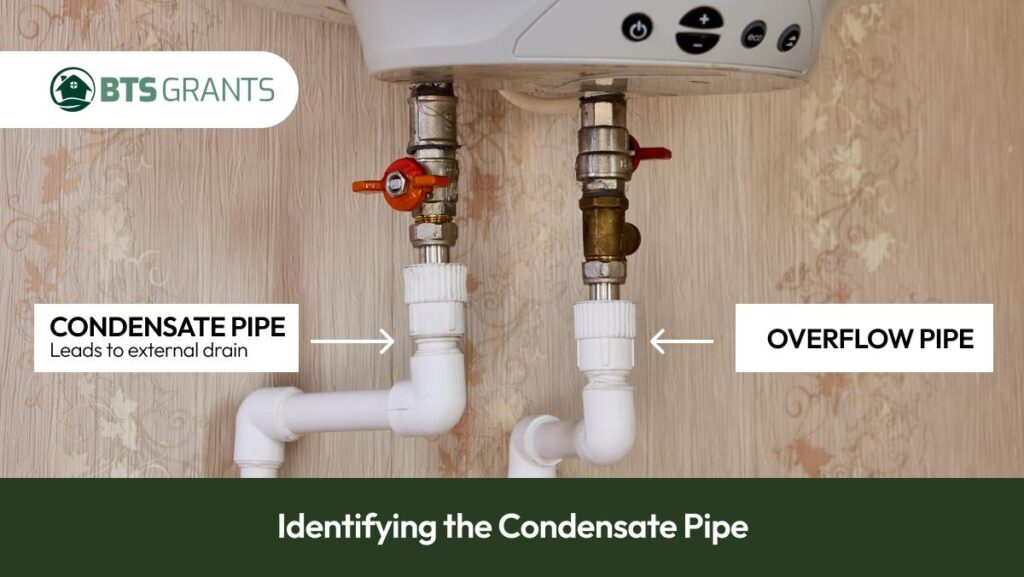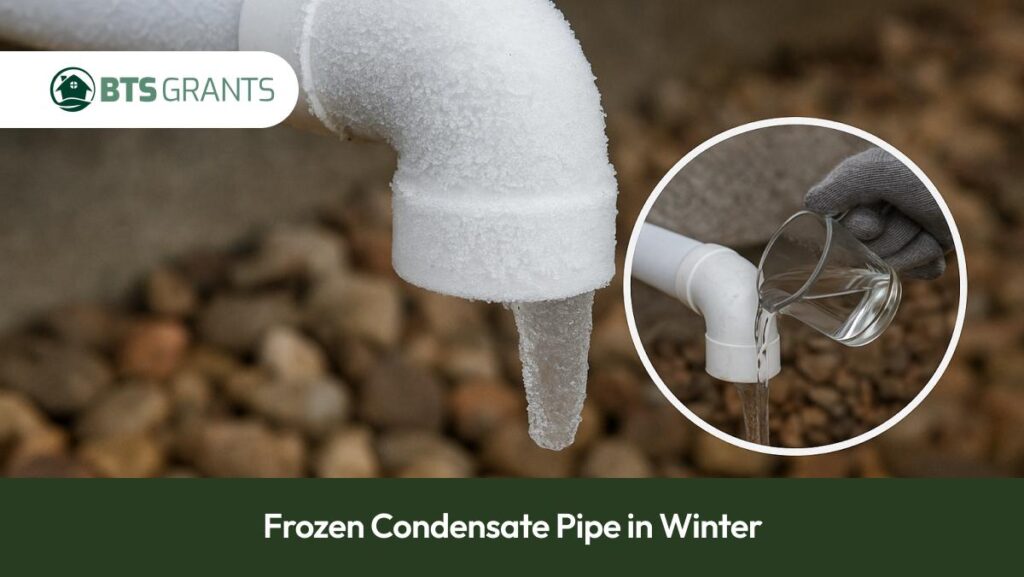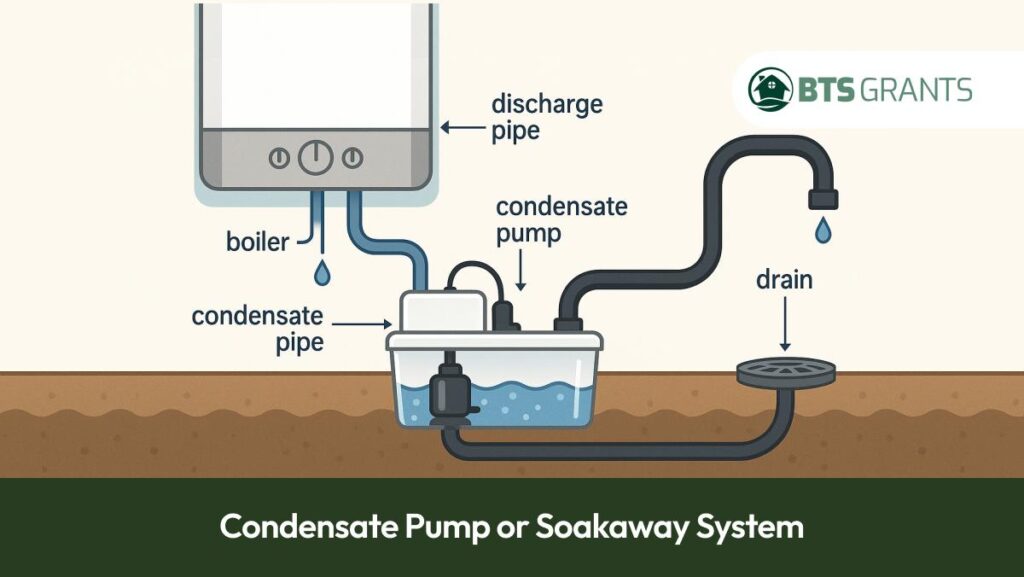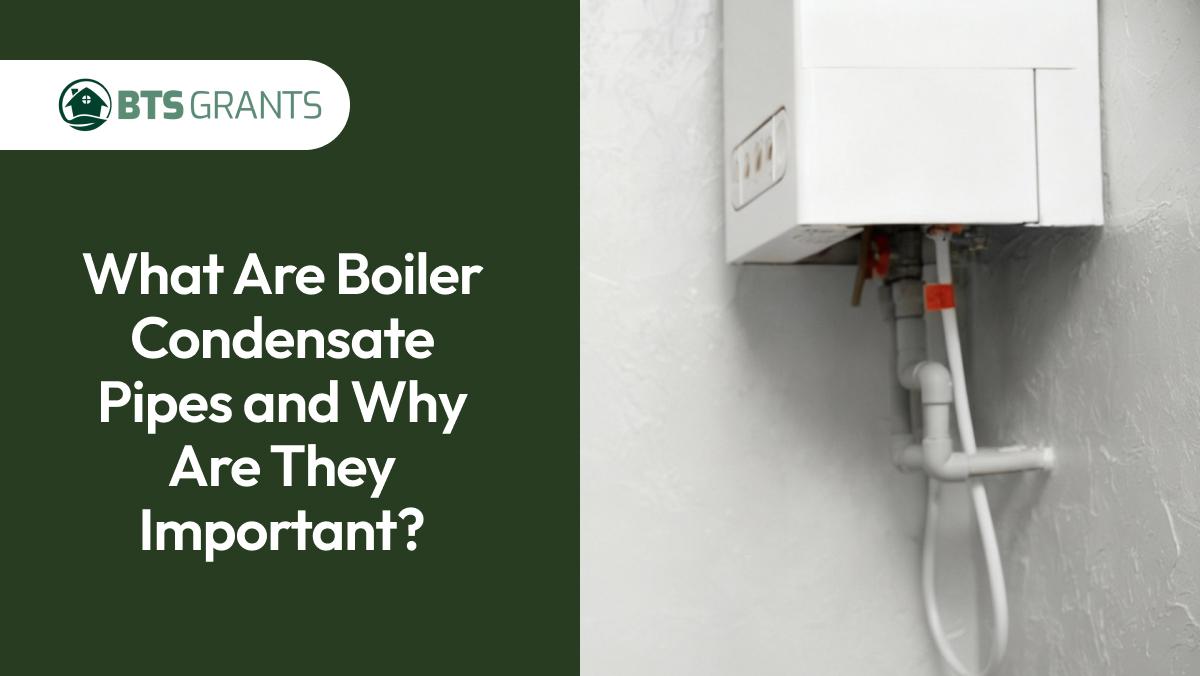Modern UK homes depend on condensing boilers for energy-efficient heating — but one tiny component tends to be overlooked: the boiler condensate pipe. Also referred to as a condense pipe or condenser boiler pipe, it silently drains off the acidic water produced during the heating process. Although it may look small, this plain condensation pipe is important for maintaining your system’s safety, efficiency, and environmental friendliness.
Here, we’ll cover everything you need to know—from how to find your boiler waste pipe to how to look out for problems, avoid winter freeze-ups, and keep your heating in top working order year-round.
What Is a Boiler Condensate Pipe?
If you have a modern condensing boiler at home, you also have a boiler condensate pipe — even if you’ve never noticed it. This small but important component carries away the acidic water, or condensate, that’s created when your boiler burns fuel to heat your home.
In the process, water vapour is created within the boiler’s heat exchanger. When this vapour is cooled, it condenses into liquid form — or condensate water — which must be safely drained away. That’s where the boiler condensation pipe (also referred to as a condense pipe or boiler waste pipe) comes into play. This carries this wastewater out to an external drain or soakaway, ensuring your boiler system remains clean and safe.
In simple terms, the condenser boiler pipe helps your heating system get rid of acidic by-products, allowing the boiler to recycle heat more efficiently. Without it, your condensing boiler couldn’t operate as intended — and your home’s energy efficiency would take a serious hit.
How to Identify Your Boiler’s Condensate Pipe


Many homeowners don’t realise their boiler has a condensate pipe until something goes wrong — like a leak or a freeze-up in winter. Understanding how to identify it can help you in avoiding problems and better know your heating system.
In most houses, the boiler condensate pipe is a white or light-grey plastic pipe (typically PVC) from the underside of your condensing boiler to an outside wall. It normally goes on to an external drain or, on some systems, a soakaway. If your system is fitted indoors and doesn’t have an adjacent drain, you may see a small condensate pump attached to assist in pushing the wastewater.
Boiler Waste Pipe vs Condensate Pipe: What’s the Difference?
It’s common to mistake a boiler waste pipe and a condensate pipe, but they serve different purposes.
- The waste pipe removes water from safety valves or overflows.
- The condense pipe, however, handles the acidic water that is created through the process of condensation in the boiler.
Since the condensate pipe is carrying acidic liquid, it’s always constructed with plastic — not copper — to avoid corrosion.
Safety Tip: Don’t even think about trying to take out or change your condensate pipe yourself. If you notice a blockage or disconnection, call a Gas Safe registered engineer to check and repair it safely.
Common Issues: Faulty or Clogged Condensate Pipes
A boiler condensate pipe is meant to drain wastewater silently — but when something breaks down, it can lead to problems. A faulty or broken condensate pipe is one of the most frequent causes that newer condensing boilers fail, particularly on cold or wet days.
Symptoms of a Blocked Condensate Pipe
A condensate pipe blocked by dirt, debris, or ice keeps wastewater from draining. When that occurs, your boiler can:
- Show a fault or error code on the screen.
- Create gurgling or bubbling noises as the water remains backed up.
- Completely shut down as a safety measure.
If your boiler abruptly turns off and you observe the symptoms above, there’s a high probability that the boiler condensate pipe is blocked.
Leaks and Cracks
Pipes can get cracked, loose, or disconnected over time if they are left outside. Leaks or drips on the wall or near the boiler may be a sign of a broken condensate pipe. Don’t try to ignore these signs — acidic water can ruin surfaces and corrode surrounding fittings.
How to Fix the Problem
Most problems with condensate pipes need to be fixed by a professional. A Gas Safe engineer can safely fix broken pipes, clear blockages, or replace bad pipework. In many cases, insulating or rerouting the pipe can help prevent future problems — especially before winter.
Why Boiler Condensate Pipes Freeze in Winter (and How to Prevent It)


When temperatures drop across the UK, one of the most common heating problems homeowners face is a frozen boiler condensate pipe. Because these pipes usually run outside, the water inside them can freeze, causing a blockage that stops the boiler from working.
Why Does It Happen?
A boiler condensation pipe or condense pipe carries small amounts of wastewater. Under cold weather, this water may freeze — particularly if the pipe is:
- Not insulated when exposed to cold air.
- Too small or has a very long outside run.
- Roughly angled, so water accumulates and freezes.
When the pipe freezes, your boiler may display an error code, make gurgling noises, or simply shut down as a safety measure. These are clear signs of a winter boiler problem caused by a frozen condensate or condensation pipe.
How to Prevent Freezing
You can lower the risk of freezing by following these simple measures:
- Insulate the pipe: Wrap any outdoor parts with foam lagging to insulate them.
- Re-route the pipe: Have an expert shorten the outdoor portion or route it inside.
- Add gentle heat: Some homeowners fit a trace heater (a small electrical wire) that warms the pipe in harsh weather.
- Use warm (not boiling) water: In case your pipe should freeze, trickle warm water over it to thaw the ice — not boiling water, however, which will harm the pipe.
By keeping your condensate pipe insulated, you’ll ensure your boiler operates efficiently and prevent winter breakdowns when you need heat most.
Can a Boiler Condensate Pipe Save Energy or Money?
It might appear to be a mere drainage pipe, yet the boiler condensate pipe plays a crucial role in the energy efficiency of your boiler. It is one of the most important parts of all condensing boilers because it helps them run cleaner and use less fuel.
How It Makes Things Work Better
A condensing boiler system takes heat that would normally go out the flue and uses it to heat your home. The process creates acidic water (condensate), which is then safely discharged through a condensate pipe.
Your boiler won’t function optimally if its condensate pipe becomes blocked or damaged, necessitating additional fuel or even stopping altogether, requiring repair work that would cost more energy to use than originally estimated.
Saving Money on Heating Bills
By maintaining your boiler condensate system in good working order, you can:
- Maintain a high level of condensing boiler efficiency.
- Save fuel that you don’t need.
- Avoid leaks or blockages that can lead to expensive breakdowns.
A well-maintained condensation pipe doesn’t directly save money, but it ensures your boiler runs at its best — which means lower heating bills and fewer surprises when winter arrives.
How Condensate Pumps Work (and When You Need One)
Not every home has an external drain close to the boiler. In such instances, a condensate pump is employed to assist in the removal of wastewater in a safe manner. It’s a brilliant little gadget that ensures your boiler drainage system functions well, even if gravity is not working in your favor.
What Does a Condensate Pump Do?
A condensate pump automatically drains the acidic water that accumulates within the boiler’s trap. When the tank is full to a specific point, the pump activates and forces the water down a condense pipe to the closest drain or soakaway.
This system helps keep your boiler condensate system running in perfect order, even if your drain is higher than the level of your boiler or far away.
When You Would Need One
You’ll usually require a condensate pump if:
- Your boiler is fitted in a garage or basement that has no direct access to drains.
- The pipe needs to travel upward or over a long distance.
- There’s no external drain available near the boiler.
Maintaining the Pump
Although condensate pumps are low-maintenance, it’s a good idea to have them checked during your annual boiler service. Periodic cleaning and testing keep your boiler condensate system safe and reliable all year long by preventing leaks and pump failures.
What to Do If There’s No External Drain – The Soakaway Option


In case there is no external drain, a soakaway condensate pipe is a handy alternative. A soakaway is a small underground system that safely spreads the wastewater from your condensing boiler into the ground.
Benefits of Using a Soakaway
- Good for the environment: It cleans condensate water naturally through the ground.
- Unobtrusive: It is placed underground, so your home is still tidy on the outside
- Low maintenance: If installed properly, it doesn’t require much attention.
Potential Problems with Soakaway
- Blockage: The system can get blocked by dirt or trash.
- Risk of freezing: If placed too close to the surface, it could freeze during winter and prevent its contents from draining properly.
- Maintenance: For your own protection and peace of mind, it is advisable to inspect the drainage system regularly to ensure everything goes according to plan.
Have one of your boiler soakaway systems inspected by a qualified engineer for added peace of mind. They can confirm it’s suitable for your home and that it meets all UK building regulations.
FAQ’S
A new condensing boiler generates anywhere between 1.5 to 2 litres of condensate water per hour, depending on the duration of its operation. Over a day, that can add up to 20 litres or more — all of which is drained safely through the boiler condensate pipe.
Use warm water, not boiling. Spilling boiling water onto a frozen condensation pipe can ruin the plastic. Warm water (around hand temperature) will gently melt the ice without harming the pipe.
Yes, it does — if the freeze is minor and near the outside end of the pipe. Warm water should be poured over the cold boiler condensate pipe to warm it up and restore flow. If freezing regularly, you should add insulation or reroute the pipe to avoid freezing in the future.
For safe and best performance, it is advisable to check your condensate pipe at least every few months (before winter) for cracks, leaks, or freeze indicators. This will help you find problems sooner.
Conclusion
Your condensate pipe may not look like much, but it has an important job: making sure your condensing boiler runs safely, smoothly, and dependably. By carrying away acidic water and recycling heat instead of wastefully sending it off into the environment, this humble condense pipe allows your boiler to reuse heat, save waste, and reduce bills significantly.
It’s always best to call a Gas Safe-registered engineer if you ever hear gurgling noises, see leaks, or get fault codes. Given proper care, your boiler condensate system will keep working efficiently — saving you energy, keeping your home safe, and providing you with peace of mind all year round.



